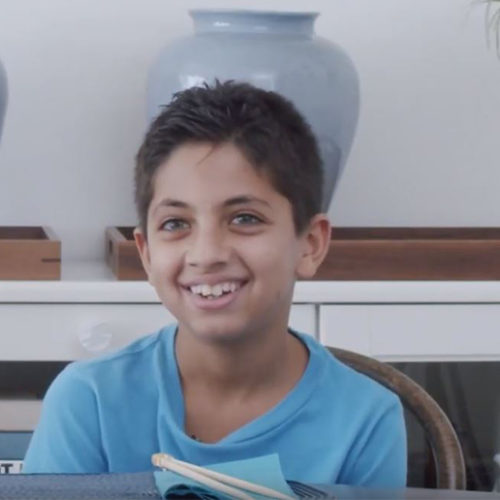Resetting your child’s circadian rhythm

Some children struggle to fall asleep, whereas others rise at dawn, seemingly no matter what. We discuss the factors that imbalance your little one’s internal clock and what you can do to reset it.
Between work constraints, the sunlight and length of darkness available in your region, seasonal shifts, caffeine intake, screen exposure, stress levels and long standing habits, it can take time to really figure out what naturally suits you best when it comes to sleep. Many of us are well into adulthood before we feel we have reached a consistent grasp of good quality, restful sleep.
Chronotypes
Science now tells us that we all have an inherent ‘chronotype’, a natural time that our particular body is more prone to sleep and wake at. Some of us are ‘night owls’, preferring to stay up later into the night and sleep in a little longer the next day, whereas others are ‘larks’, those that can happily snooze away from 9pm and get up with the birds, before everyone else.
Studies suggest that only about 10 percent of people are true ‘larks’, those who feel most normal when sleeping from 9pm to 5am. On the other hand, less than 15 percent are real ‘owls’, for whom sleeping from 2am to 10am feels fully natural. The majority of us fall somewhere in between the two.
Children and sleep
It adds a whole other dynamic to the situation to not only have to deal with your own sleeping habits and chronotype, but also grapple with your child’s sleep habits, particularly if it’s at odds with yours or your family’s. Some parents struggle to get their little one to sleep before 10pm while others have such early birds at home that the sun is barely up when they spring out of bed and nothing appears to keep them asleep any longer. However, there are some great ways to help shift their schedule towards something a little more workable for your household.
How much sleep does my child need?
No matter when your child goes to sleep or rises, all kids need an adequate amount of sleep for their physical and mental health, as well as their brain development. Here is a short guide to help you see how much sleep your child needs per night at different ages:
- Babies under a year typically need 12-16 hours of sleep in total
- Toddlers between 1 and 2 years old require 11-14 hours
- Between 2 and 5 years, most children need 10-13 hours
- By the age of 12, this drops to somewhere between 9 and 12 hours
- Most teenagers need 8 to 10 hours
Larks, owls or habits?
Happily for most parents, the average child is likely to naturally fall somewhere in the middle of the spectrum, aligning nicely with the way society has set up our school and work days. However, if you consistently notice your little one has the most energy and alertness in the evening or very early in the morning, no matter what time they went to bed or how much activity they did that day, you may have an owl or a lark under your roof. This usually becomes clearer around the age of 4, once your little one has dropped their daytime naps. There are many factors that influence and shift these sleep habits – it’s only partially based on genes and natural chronotype. Some of these include age, level and amount of exercise, how much sunlight they receive each day and their diet. The research is not in agreement about how exactly our emotional state, nutrition and activity affect our chronotype, but one thing is very clear – the biggest factor is definitely light.
The role of light
Bright light, especially sunlight, has the most powerful influence over regulating your internal clock or circadian rhythm. How exactly it achieves this is complex, but boils down to the concept that exposure to bright light causes the body to suppress its production of melatonin, a hormone that creates sleepiness. When this happens, we feel sharp, awake and alert. The brighter the sunlight or light, the longer and better your body subdues melatonin, meaning we don’t really feel tired.
In the modern era, this mechanism presents a problem, as other light sources besides sunlight can send your internal clock out of balance. Studies indicate that the blue light emanating from screens, smartphones, tablets, laptops and even e-readers can suppress melatonin, delaying and interfering with our ability to sleep. Many people advocate for a ‘digital sunset’, or a time in the early evening where you put away all screens and focus only on non-digital activities, like reading, art, chatting, card games or board games. Whatever you choose, know that once you control your child’s exposure to artificial and natural light sources, you will be able to nudge their body to reset its internal sleep schedule.
Moving bedtime back
Children who are natural owls are very sensitive to the effects of light exposure in the evening. This delays their ability to fall asleep, something they already struggle to do. Owls need less light exposure at night and plenty of exposure in the morning. If you have a night owl on your hands, try stopping all screen use at least an hour before their bedtime routine starts. The second part of resetting your little owl involves exposing them to lots of sunlight or at least bright light early in the day. This will help their bodies to suppress melatonin better so they naturally begin waking up earlier, with more alertness in the first half of the day. In turn, this makes it easier to fall asleep at an earlier hour. With consistency, bright light in the morning and dim light in the evening will reset their clock to earlier times. This could look like eating breakfast in a sunny spot, opening the curtains in the bedroom, walking to school in the sunshine, or simply going outside before school.
Moving wake up time forward
Other parents will have the opposite problem on their hands – a child who wakes up too early, seemingly no matter what. These kids need to sleep longer in the morning, so again light can be used to help achieve this. Try blocking out morning light by using blackout curtains or a sleep mask if your child is comfortable. The second step is to consider ways you may be accidentally setting your little one up for an early start. Is your child allowed extra screen time if they rise early? Are they treated to a snooze in their parents bed? The advice is to remove the benefits so they can no longer serve as motivation – i.e. not allowing screens in the morning or only allowing cuddles in your bed after a certain hour. Thirdly, try using a visual signal to train your child to only get out of bed at a specific time. These signals can be a nightlight on a timer that turns on when it’s ‘wake up time’. You can also buy special children’s clocks that use fun features such as smiley faces, animals, lights, suns and moons to tell children when they should be in bed and when it’s okay to get up. Traditional alarm clocks are not so advisable before your child is fluent at telling the time as figuring this out can be quite difficult for most kids, and concentrating that much can actually leave little ones more awake than before.
Lifestyle considerations
Always keep other lifestyle factors in mind when it comes to your child’s sleep health. Watch out for caffeine in unexpected sources such as chocolate, cola drinks and even chocolate milk. Intaking these in the late afternoon or evening can set kids back when it comes to bedtime. For some, physical activity produces a burst of energy, whereas for others it can simply help them to fall asleep well. It’s good to pay attention to when your child exercises and how this appears to affect them. Kids also tend to be highly stimulated by films, social media, video games and sometimes even exciting non-digital activities like listening to loud music, playing a competitive game or simply reading a very exciting story. Try to match the evening’s activities in a decreasingly stimulating order towards the slope of bedtime. Activities like yoga, baths and classical music can help little ones really unwind and feel sleepy. Be consistent with bedtime routines and sleep schedules, even on the weekend. Going to bed and rising at the same time every day is one of the most habitually positive things you can do to train your child’s internal clock. A word of warning – make sure to schedule fun time into the afternoon so your child feels satisfied with the balance of their day and things don’t end up piling up at the end of the day.
Using your understanding of chronotypes, you should be able to identify your little one’s sleep category. Armed with this knowledge, you can employ the reset techniques for larks or owls to balance out your child’s circadian rhythm, so they sleep better than ever – and you also get the rest you deserve!
Image Credit: ShutterStock











Comments